Recreational Fishery
Stock Assessment
1999 Final Report
|
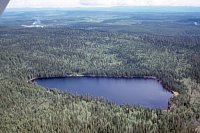
PHOTO 1. Clear Lake
Aerial Photo. June 2001.
Click
image to view 72K JPG |
|
|
|
Introduction
This report presents the results of a stock assessment
of Clear Lake, completed by Ted Zimmerman and Sean Barry
on June 25, 1998. Clear Lake was initially stocked with
rainbow trout in 1984.
The assessment was carried out as part of a region-wide
stocked lake monitoring program, in which Clear Lake ranked
as a high priority for investigation. This report follows
up on previous surveys conducted by the Ministry in 1985
and 1988, and provides management
recommendations for the Clear Lake recreational fishery.

Methods
An experimental, 91.2m sinking monofilament gill net was
set in Clear Lake on June 25,1998 according to the methods
outlined in the Resource Inventory Committee document Fish
Collection Methods and Standards. The net was deployed
at 11:32 and retrieved the same day at 17:28, for a total
soak time of 5 hours, 56 minutes.
| |
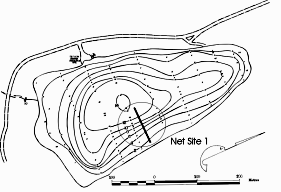 FIGURE 1. 1998 Net set location
FIGURE 1. 1998 Net set location
Click image to view 45K GIF |
|
The net was set 8 m from the east shore in an E-W direction
(Figure 1). The net ranged
in depth from the surface to 14m.
All trout collected were sampled for fork
length and weight. Due to the large numbers of yearlings
captured, sex and maturity were measured from only a subsample
of the smaller fish (Appendix 1).
Scale samples were collected from all fish larger than
180mm, and from a sub-sample of those smaller than 180mm.
The structures were sent to Darlene
Gillespie of TimeMark Consulting Ltd.(Nanaimo, B.C.)
for ageing. Upon return to the Ministry, scale prints were
subsequently checked and ages were adjusted by the author
to account for anomalies between the ages reported by the
contractor and the known stock
schedule and age composition of rainbow trout in Clear
Lake.

Results and Discussion
CATCH SUMMARY
The net catch yielded 83 rainbow trout (RB), for
a catch per unit effort of 14.0 RB per net-hour. No other
fish were netted. See Appendix
1 for individual rainbow trout sample data.
Table 1. Population attributes of rainbow trout sampled
in Clear Lake, June 25, 1998
| Attribute |
Mean |
Range |
SD |
| Length |
190 |
121-414 |
88 |
| Weight |
134 |
20-675 |
197 |
| Condition |
1.11 |
0.83-1.37 |
0.08 |
ANALYSIS
| |
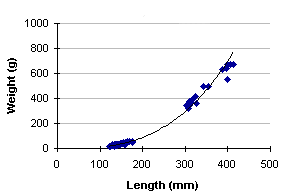 FIGURE 2. Length vs. weight of rainbow trout
captured in Clear Lake, June 1998.
FIGURE 2. Length vs. weight of rainbow trout
captured in Clear Lake, June 1998. |
|
Condition
The weight of Clear Lake rainbow trout increased according
the equation W = 1E-5 x L^2.9908; this relationship is expressed
in Figure 2. This figure shows that Clear Lake rainbow
trout are generally in good condition, however the 5-year-old
cohorts were slightly lighter for their length than the
younger cohorts sampled. This trend has been observed across
numerous lakes in the region, and is a normal occurrence
for larger planktivorous trout. The older fish also appeared
to be quite healthy with no noticeable parasites or lesions.
| |
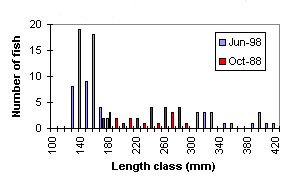 FIGURE 3. Length frequency distribution
of rainbow trout captured in Clear Lake, comparing
1998 and 1992 results. FIGURE 3. Length frequency distribution
of rainbow trout captured in Clear Lake, comparing
1998 and 1992 results. |
|
Size Distribution
Figure 3 compares the 1988 and 1998 length-frequency
distributions of rainbow trout sampled in Clear Lake. The
1998 sample is dominated by large yearlings, which were
stocked into Clear Lake on May 28. The 1993 and 1995 cohorts
are represented by the 310-350 mm and 390-420 classes respectively.
By contrast, the sample collected in October 1988 contains
no fish larger than 290 mm, even though the sample was obtained
after a full growing season and is represented by age classes
1 to 4. This suggests that the growth of each cohort was
constrained such that their size distributions overlapped
between year classes.
Growth
It can be seen from Figure 4 that the 1988 population
exhibited slower growth relative to those fish sampled in
1998. No fish were older than 4 years in the 1988 sample,
however several 5 year old fish were obtained in 1998. The
mean length of an age 3 rainbow trout increased from 244mm
in 1988 to 321mm in 1998, an increase of 32%. This increase
in growth is also reflected in the change to the mean weight
of age 3 fish (not shown), from an average of 154g to 395g,
an increase of 156%. Had the 1998 survey been conducted
in October, the difference in growth rate would have been
even more pronounced.
| |
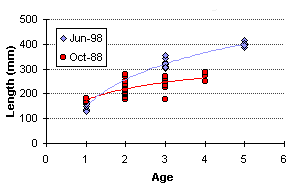 FIGURE 4. A comparison of 1988 vs. 1998 Clear
Lake rainbow trout growth rates.
FIGURE 4. A comparison of 1988 vs. 1998 Clear
Lake rainbow trout growth rates. |
|
Several factors are likely responsible for the observed
increase in growth. The stocking
frequency was changed from yearly to alternate years
in 1988, the stocking rate was reduced from 2,500 fish to
1,500 fish in 1996, and the mean size at stocking increased
during each stocking event to a maximum of 17.2g in 1996.
A growth response may be attributable to changes in the
strain of fish stocked as well, although this is difficult
to quantify as there is no data available on relative growth
rates of the various strains currently being stocked.
While the data suggests that growth has indeed improved
in recent years, it should be noted that some level of error
was associated with the scale reading process for the current
study. Eight fish were originally classified as 4-year-olds,
yet it is assumed that there is no natural recruitment in
Clear Lake (since the lake has no inlets, required for spawning)
and therefore no fish of this year class would be expected
in the sample. A secondary examination of the scale prints
revealed that with the exception of two scales, all the
fish classified as 4-year-olds were likely either 3 or 5
year old fish. The two exceptions (sample
no. 25 and 28) were difficult to classify and were subsequently
assigned as 3-year-olds. The original and adjusted ages
of each fish can be found in Appendix
1.

Management Recommendations
The rainbow trout fishery in Clear Lake has shown a remarkable
improvement since 1988, a change that is no doubt attributable
to the reductions in both the number of fish released and
the frequency of those releases. The initial stocking rate
likely exceeded the productive capacity of the lake, resulting
in excessive intraspecific competition and abated growth
amongst stocked fish. Currently, Clear Lake contains rainbow
trout which are well conditioned and reasonably sized, and
should provide a satisfactory recreational fishing experience.
No further changes are recommended to the management strategy
for this lake.

Literature Cited
Westcott, R. 1988. Note to file
regarding the 1988 stock assessment of Clear Lake. Ministry
of Environment, Lands and Parks. Prince George.

For More Information:
Contact :Ted
Zimmerman
Sr. Fisheries Biologist, Omineca sub-Region
Prince George, B.C.
250-565-6852 |
